Summary
Between 2017 and 2020, wind erosion was a major issue with significantly elevated dust levels and loss of topsoil arising from recent drought conditions across western and central NSW.
The main ongoing issues contributing to deterioration in soil condition and productivity across NSW are increasing acidification and the continuing decline of soil organic carbon in agricultural soils due to the intensification of land use.
Why soil condition is important
Soils make a significant contribution to the ecological integrity of the environment and economic prosperity of NSW. Healthy soils deliver essential ecosystem services, including:
- nutrient transformation and cycling
- water infiltration and filtering
- climate regulation through carbon storage and cycling
- providing habitat for biota
- supporting natural ecosystems
- enabling farming for food and resources.
Soil is a non-renewable resource, as its formation is an extremely slow process beyond human timeframes (; ). Therefore, to maintain productivity and ecosystem services, soils must be managed sustainably to prevent them becoming degraded.
NSW indicators
| Indicator and status | Environmental trend |
Information reliability |
|
|---|---|---|---|
| Soil pH (acidification) |
|
Getting worse | ✔✔ |
| Organic carbon |
|
Getting worse | ✔✔ |
| Wind erosion |
|
Getting worse | ✔✔ |
| Hillslope erosion |
|
Stable | ✔✔ |
| Salinisation |
|
Stable | ✔✔ |
| Acid sulfate soils |
|
Getting better | ✔✔ |
Notes:
Terms and symbols used above are defined in .
Status and Trends
The increasing intensity of land use, climate variability and extreme weather events, are the greatest risk factors in maintaining soil condition and the provision of ecosystem services.
Conservation farming practices introduced over recent decades, including the maintenance of groundcover vegetation and reduced tillage, are helping to mitigate erosion and declines in some soil condition parameters in the face of ongoing and increasing pressures.
Spotlight figure 10: Average dust hours and area with less than 50% total vegetation cover recorded at NSW DustWatch stations
The Spotlight figure 10 shows dust hours recorded were 4.2 times the average levels of the previous 10 years and wind erosion worsened across NSW with negative impacts on soil loss and air quality.
The average area of less than 50% groundcover has increased from the previous 10-year average of 14% to 25% over the past three years, attributable to extreme climate conditions.
Pressures
While land management practices have generally improved, the pressure on soil condition continues due to the increasing intensity of land use across NSW. There is, therefore, a greater need to ensure that soils and land are managed sustainably and within their inherent physical capacity to handle a specific level of disturbance or use.
While soil may be managed sustainably with little risk of degradation in normal weather, the unpredictability and variability of severe weather events can rapidly reduce its capacity to absorb disturbance, leading to loss of soil condition and degradation.
Due to a changing climate, these conditions are likely to occur more frequently, leading to a greater focus on how to retain and manage groundcover.
Responses
Legislation and policies to regulate soil conservation and the clearing of native vegetation include the:
These laws aim to achieve a balance between land use and biodiversity conservation in NSW.
Policies for sustainable soil management in NSW include:
- State Environmental Planning Policy (Rural Lands) 2008
- the Policy for Sustainable Agriculture in NSW ()
NSW is a signatory to the National Soil Strategy which provides a national framework for coordinated action on soil by governments, industry and stakeholders.
Eleven regional natural resource management bodies, under Local Land Services (LLS), are working with local farmers, landholders and communities, including Landcare groups, to develop strategies and programs to improve natural resource management and sustainable land use across NSW.
Farmers and landholders are also independently adopting improved land management practices, due to a greater awareness of, and commitment to, sustaining their operations and protecting environmental values.
Related topics: |
Context
The consequences of most types of soil degradation, such as soil loss from accelerated erosion, dryland salinity and subsurface acidity, are long-term and often irreversible or costly to reverse. While some other forms of degradation, such as nutrient decline and surface soil acidification, may be remediated if addressed early, restoration is often expensive although possibly cost-effective (). Applying best management practices can prevent or even reverse some degradation processes in rural production landscapes.
While most soils are in a moderate condition, some parts of the state have suffered a greater decline in condition than others and display a significant loss in their ability to deliver ecosystem services relative to pre-European times. Much of the change in soil condition has occurred over longer timeframes, largely reflecting historic losses due to the earlier lack of knowledge about managing soils sustainably in Australian conditions.
Other factors such as loss of topsoil due to hillslope erosion, salinisation and the occurrence of acid sulfate soils are of lesser concern and appear to be stable or decreasing in impact.
Status and Trends
Introduction
This topic describes changes in soil condition that have occurred over the past 10–15 years. It refers to six characteristics of soil condition that provide a useful description of the status and trends in soil health and land management across NSW. These soil characteristics are:
- soil pH, particularly acidification, (the lower the pH of the soil, the higher its acidity)
- soil organic carbon (SOC)
- hillslope erosion
- wind erosion
- salinisation
- acid sulfate soils (ASS).
There is a close relationship between the characteristics of soil condition and the degradation processes that result in a decline in soil ecosystem services and damage to the broader environment, as described in Table 10.1.
Table 10.1: Characteristics of soil condition and associated processes causing land degradation
| Soil characteristic | Degradation process | Characteristics of the degradation processes |
|---|---|---|
| Soil pH | Acidification | Soil pH is an important chemical characteristic of soil health. Most plants and crops grow best in soils that are slightly acidic to slightly alkaline, although many native plants grow well in low pH (acid) soils. Both strongly acidic and strongly alkaline conditions affect plant growth. However, trends to more acid soils are of more widespread concern. Acidification can be exacerbated by intensified land management with the associated leaching of soil nutrients, the use of acidifying nitrogen-based fertilisers and export of organic materials as produce. |
| Soil organic carbon | Loss of organic carbon | The level of organic carbon is an important determinant of the soil’s biological health which promotes recycling of soil nutrients and improves soil structure. A decline in organic carbon in soils is generally due to vegetation clearing and changes in land management, leading to reduced replenishment of organic matter and greater losses to the atmosphere. |
| Hillslope erosion | Loss of topsoil | Topsoil is the soil layer that best supports plant growth as it contains most of the nutrients and organic matter. Topsoil’s structure supports root development and the uptake of nutrients and water. Removing the topsoil harms the health of vegetation and encourages erosion. Hillslope erosion, including sheet and rill erosion, is caused by rain splash and diffuse water flows during heavy rain, with soils and their nutrients flowing into waterways where they affect water quality and aquatic ecosystems. In extreme cases gully erosion can occur. |
| Wind erosion | Loss of topsoil | Wind erosion is caused by strong winds in dry conditions. Many soils have eroded in the past to the extent that the loss of topsoil has substantially impacted productivity. Some of these areas recover naturally, but others require active reclamation. Wind erosion is a serious threat when soils are bare or the area of groundcover falls below 50%. Reduction in groundcover is caused by poor growing conditions (especially drought), clearing, overgrazing, cultivation and burning. |
| Soil salinity | Salinisation | Soil salinity is the accumulation of salt on or near the ground surface due to rising watertables. It is caused by land-use practices that alter the hydrological balance of the landscape, such as vegetation clearing, poor drainage and excessive irrigation of crops or pastures, particularly with salty water. Soil salinity has impacts on land and surface water quality. An excessive level of salt in soil is detrimental to plant growth and other ecosystem processes. |
| Acid sulfate soils | Acidic water contamination | Acid sulfate soils develop in aquatic and estuarine environments containing pyrites (iron sulfide). The exposure of pyrites to oxygen through activities, such as drainage, excavation and dredging, leads to the generation of sulfuric acid. The soils are also often highly saline. Thus, disturbance of these soils and the release of acid solutions can cause severe problems, including degradation or loss of aquatic ecosystems and adjoining vegetation and corrosion of building foundations and underground services. |
The last comprehensive statewide assessment of soil condition and the extent of sustainable land management occurred in 2008–09 through the NSW Monitoring, Evaluation and Reporting (MER) Strategy program as reported in OEH (). The MER assessment found that soil condition in NSW was generally moderate. However, 74% of the state faced at least one soil condition issue of some concern which varied from region to region. These outcomes demonstrated the need to manage soils sustainably, with land-use practices appropriate for, and adapted to, specific sites.
The approach adopted in this report builds on the broad-scale information collected in the MER program and updates results with the most recent data available from ongoing assessment programs, such as Community DustWatch, as well as new satellite-derived groundcover mapping and land-use data.
Soil pH (acidification)
Naturally occurring acidic soils are widespread over much of NSW. Acidification induced by agricultural activity exacerbates natural soil acidity and can affect the productivity of soils. The condition of soil pH (acidity) is best represented by the decline in pH relative to the natural pH levels. The decline has been moderate on a statewide basis but there are still significant areas where soil pH is now too low for agriculture. There is a statewide trend towards increasing acidification, with potential implications for agriculture.
Current pH levels in the top 10 and top 30 centimetres of soil were modelled in 2020, with the upper results shown in Map 10.1. These were derived using a similar methodology to that described in OEH ().
The map displays many areas of high acidity (low pH), particularly in the eastern and central tablelands regions, tending towards more alkaline conditions in the drier western regions of the state. Acidic conditions and associated toxicities inhibit the growth of many agricultural crops, particularly when pH (measured in calcium chloride – CaCl2) falls below 4.5 ().
Map 10.1: pH levels in the top 10 centimetres of soils in NSW, 2020
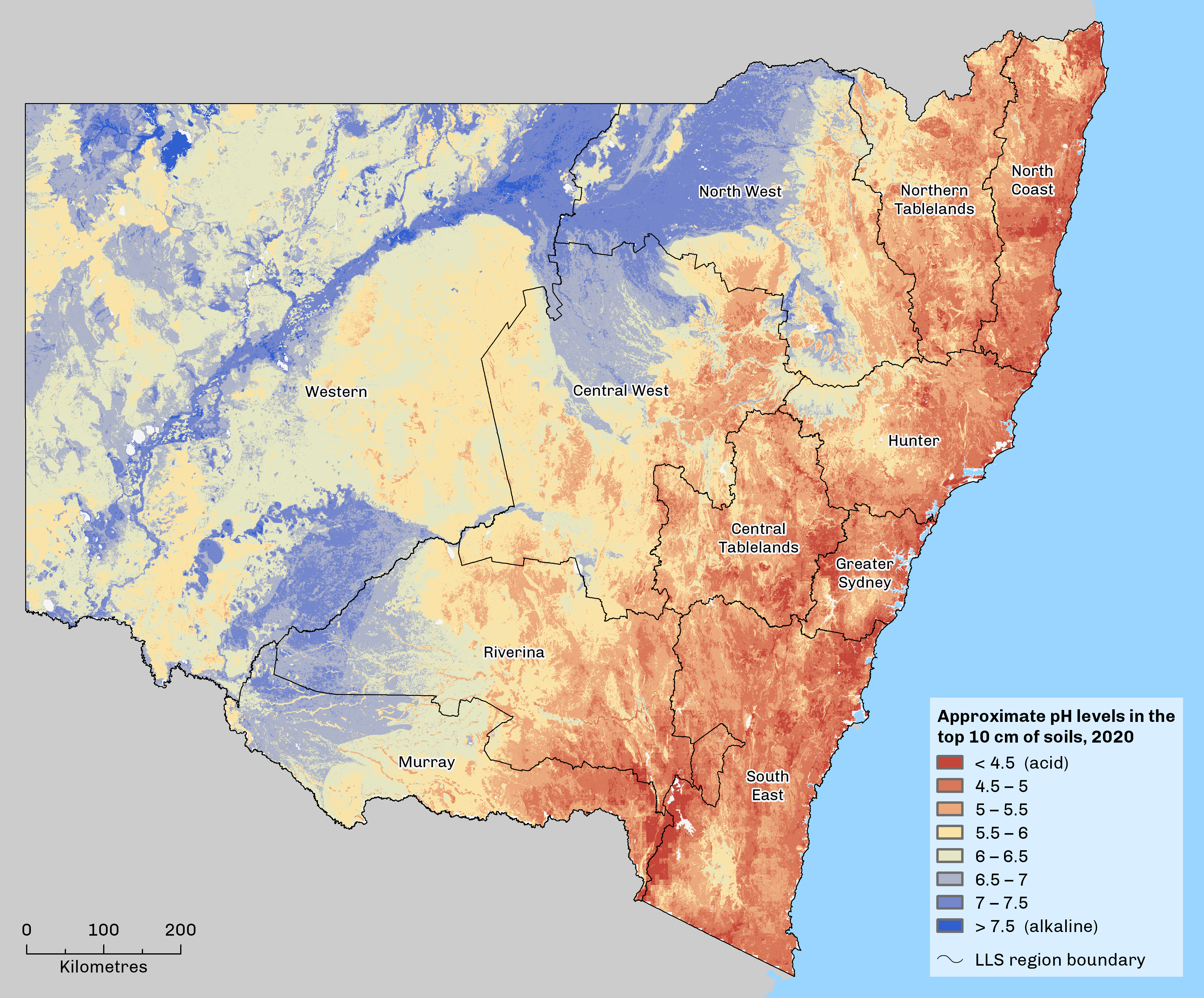
Notes:
Access the interactive version of this map.
All pH measurements refer to laboratory analysis by the CaCl2 method, the standard method for measuring pH in soil in Australia. pH measured in CaCl2 is normally between 0.5 and 0.9 units lower than pH measured in water and more accurately reflects the conditions experienced by plants in soil (NSW Agriculture 2000; Hazelton & Murphy 2016).
The change in pH levels in the top two soil depth intervals over the past 15 years (2006–2020) was also modelled for all agricultural areas of NSW (that is, all land excluding nature conservation reserves, production forests and the rangelands of the Western Local Land Services region). This modelling incorporated changes in land use and groundcover but did not consider the application of lime (an ameliorant to raise pH) due to lack of suitable data or changes in climatic conditions. Exclusion of the use of lime means that the data on acidification is likely to be the worst case scenario.
The results for the top 10cm are presented in Map 10.2, which reveals a moderate overall trend to more acidic soils, particularly in central southern NSW.
Map 10.2: Modelled change in pH levels for the top 10 centimetres of soil for the period 2006–20
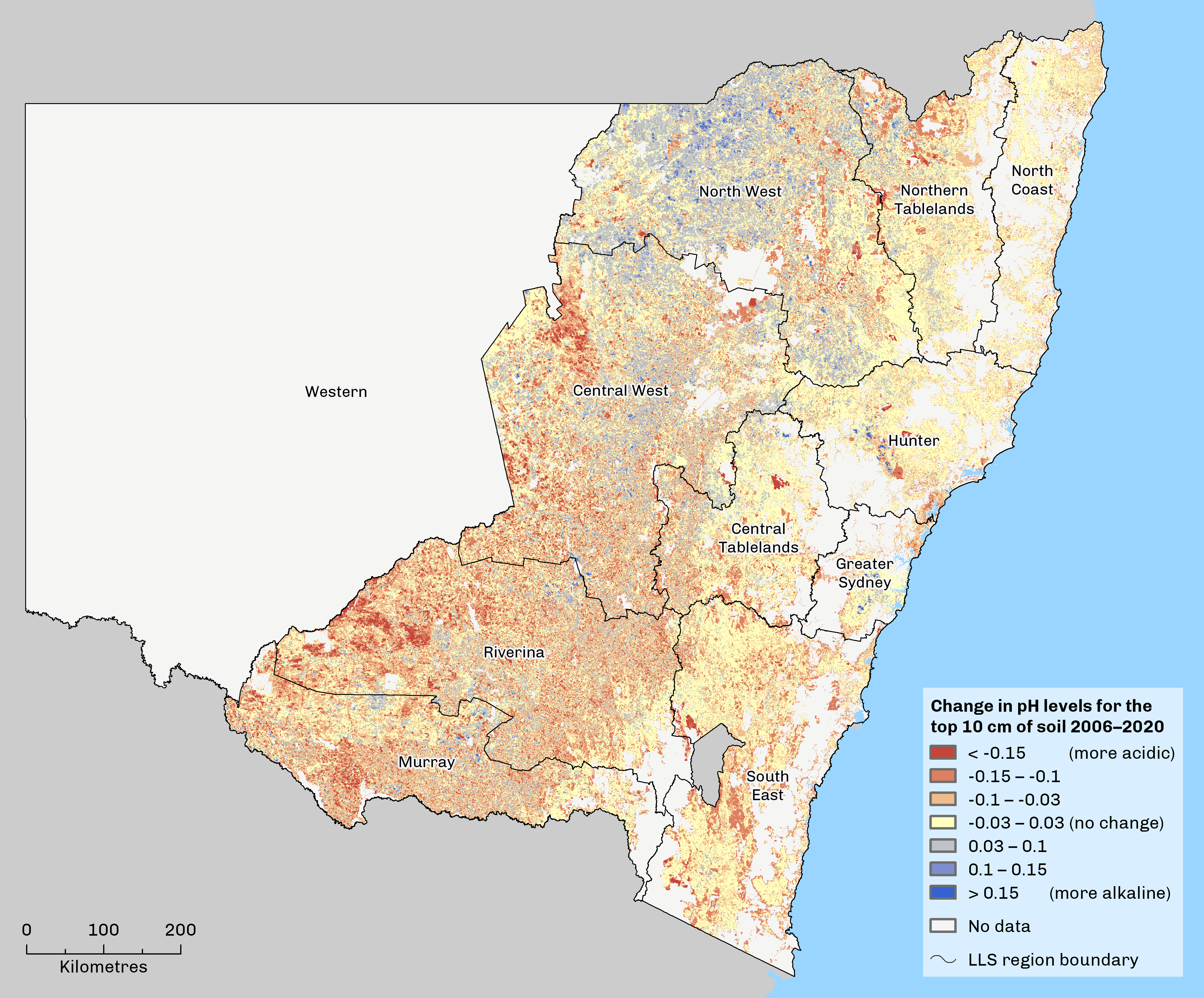
Notes:
Access the interactive version of this map.
All pH measurements refer to laboratory analysis by the CaCl2 method, the standard method for measuring pH in soil in Australia. pH measured in CaCl2 is normally between 0.5 and 0.9 units lower than pH measured in water and more accurately reflects the conditions experienced by plants in soil (NSW Agriculture 2000; Hazelton & Murphy 2016).
The modelling suggests that much of the state’s agricultural land is becoming slightly more acidic with pH declines of 0.15 pH units or more. This trend towards acidification is most evident in the Riverina, Murray and Central West Local Land Services (LLS) regions. Even minor declines in pH can harm crop and pasture growth, especially when pH levels are already critically low. This is particularly the case with acid-sensitive crops and pastures.
Slight increases in pH levels leading to soil alkalinity of more than 0.1 pH units are also indicated in some central and northern regions, affecting about 3% of NSW agricultural land.
Modelled changes in pH levels for the top 10 and 30 centimetres of soil are presented in Table 10.2 for all LLS regions in NSW. The highest average decline occurs in the Riverina and Murray regions with mean declines of 0.05 and 0.04 pH units, respectively.
Table 10.2: Modelled changes in mean pH levels, soil organic carbon and hillslope erosion by region
| LLS Region | Change in pH level (0-10 cm) |
Change in pH level (0-30 cm) |
Change in soil organic carbon - t/ha (0-30 cm) |
Hillslope erosion (% change) |
|---|---|---|---|---|
| Central tablelands | -0.02 | -0.01 | -4.8 | 9.5 |
| Central West | -0.03 | -0.01 | -4.0 | 4.7 |
| Greater Sydney | -0.02 | -0.01 | 1.4 | 35.3 |
| Hunter | -0.02 | -0.01 | -6.3 | -18.4 |
| Murray | -0.04 | -0.02 | -1.0 | -19.2 |
| North Coast | -0.03 | -0.02 | 0.89 | -12.8 |
| North West | -0.01 | 0.00 | -6.6 | -16.9 |
| Northern Tablelands | -0.02 | -0.01 | -6.4 | -24.2 |
| Riverina | -0.05 | -0.02 | -0.6 | -13.5 |
| South East | -0.04 | -0.02 | -2.1 | 17.7 |
| Western | - | - | 0.0 | -19.9 |
| NSW | -0.03 | -0.01 | -1.8 | -5.2 |
Notes:
Changes in pH and soil organic carbon are over the period 2006–20.
pH change is modelled only over agricultural lands and excludes the Western LLS.
Hillslope erosion percentage change is from 2018–20 relative to the average of the previous 18 years.
Negative figures for hillslope erosion describe reduced erosion levels.
The value for all NSW is not the simple average of the LLS regions, due to their differing area
The trends in pH change from 2006–2020 described above and shown in Map 10.2 should be considered in conjunction with data on current pH levels as shown in Map 10.1. Areas with already very low pH that show further declines in pH are locations of particular concern for acidification. McKenzie et al. () mapped acidification risk across Australia based on the threat from further decreases in pH related to current acidity, buffering capacity and land management pressures. Map 10.3 shows the simplified areas of acidification risk in NSW from their analysis.
Map 10.3: Soil acidification risk across NSW

This analysis identified that:
- approximately 20% of modified agricultural land (excluding rangelands) in the northern, central and southern tablelands and south-western slopes of NSW was at high risk of serious acidification
- a further 60% of modified agricultural land was at medium risk
- seven of the 11 LLS regions had widespread acidification risk which threatens the long-term viability of agricultural businesses if left untreated.
The overlap between the areas of declining pH over the past 15 years (identified by the current DPIE modelling in Map 10.2) and high acidification risk (identified by in Map 10.3) occurs over much of the Central West, Riverina and Murray LLS regions. These overlapping areas are the locations of highest concern.
The Land chapter of Australia State of the Environment 2016 (), also reveals widespread areas across NSW with significant soil acidification hazard, particularly in the agricultural lands of southern NSW.
The trend towards higher acidification associated with agriculture has been widely reported recently across NSW and for all of Australia (; ).
The main reasons for increased acidification in soils used for agriculture are:
- an increase in the intensity of land use over the past 10 years, with more improved pastures and an expansion of cropping lands
- the greater removal of organic matter from the soil, through farm produce
- more extensive use of nitrogenous fertilisers.
The current DPIE modelling has revealed potential trends toward increased soil acidification, based on intensification of agricultural land use and an associated decrease in annual vegetation cover. It has not considered the influence of adaptation and mitigation measures, such as the use of lime, to minimise the potential acidification threats. Inclusion of data on such land management measures would improve the assessment of trends relating to soil acidification across NSW.
Organic carbon
Soil organic carbon (SOC) enhances soil condition, as it contributes to many desirable processes including:
- higher biological activity
- improved nutrient availability
- healthier soil physical structure
- water-holding capacity and aeration (; ; )
- reduced soil erosion
- offsetting atmospheric carbon levels which mitigate climate change (; ; ).
Current SOC stocks for the top 30 centimetres of soil across NSW have been derived through spatial modelling of soils using the methodology described in OEH (). The results are displayed in Map 10.4. SOC stocks vary across NSW, with generally lower levels in western regions of the state, primarily due to the drier climate ().
Map 10.4: Soil organic carbon stocks for the top 30 centimetres of soil across NSW, 2020
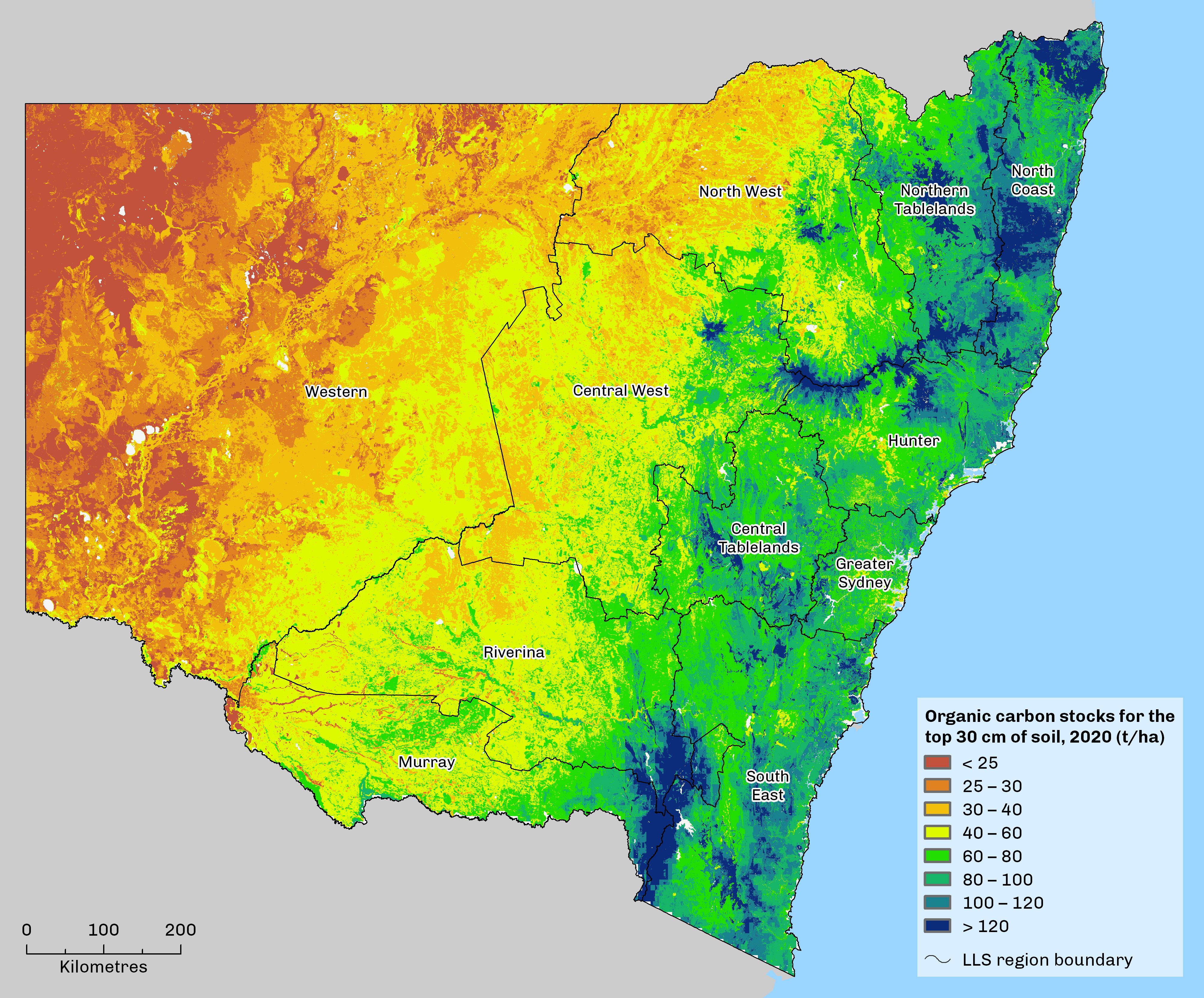
The SOC condition of soils across NSW is moderate, based on the change in current stocks relative to natural (pre-European) stocks and the associated loss of soil quality and function. The modelled trend for this indicator is slightly declining across NSW.
The change in SOC levels over the 15 years to 2020 was also derived through modelling based on data for changes in land use, groundcover and the past 10 years of rainfall and temperature records. The spatial results are presented in Map 10.5.
Map 10.5: Change in NSW soil organic carbon stocks for the period 2006–20
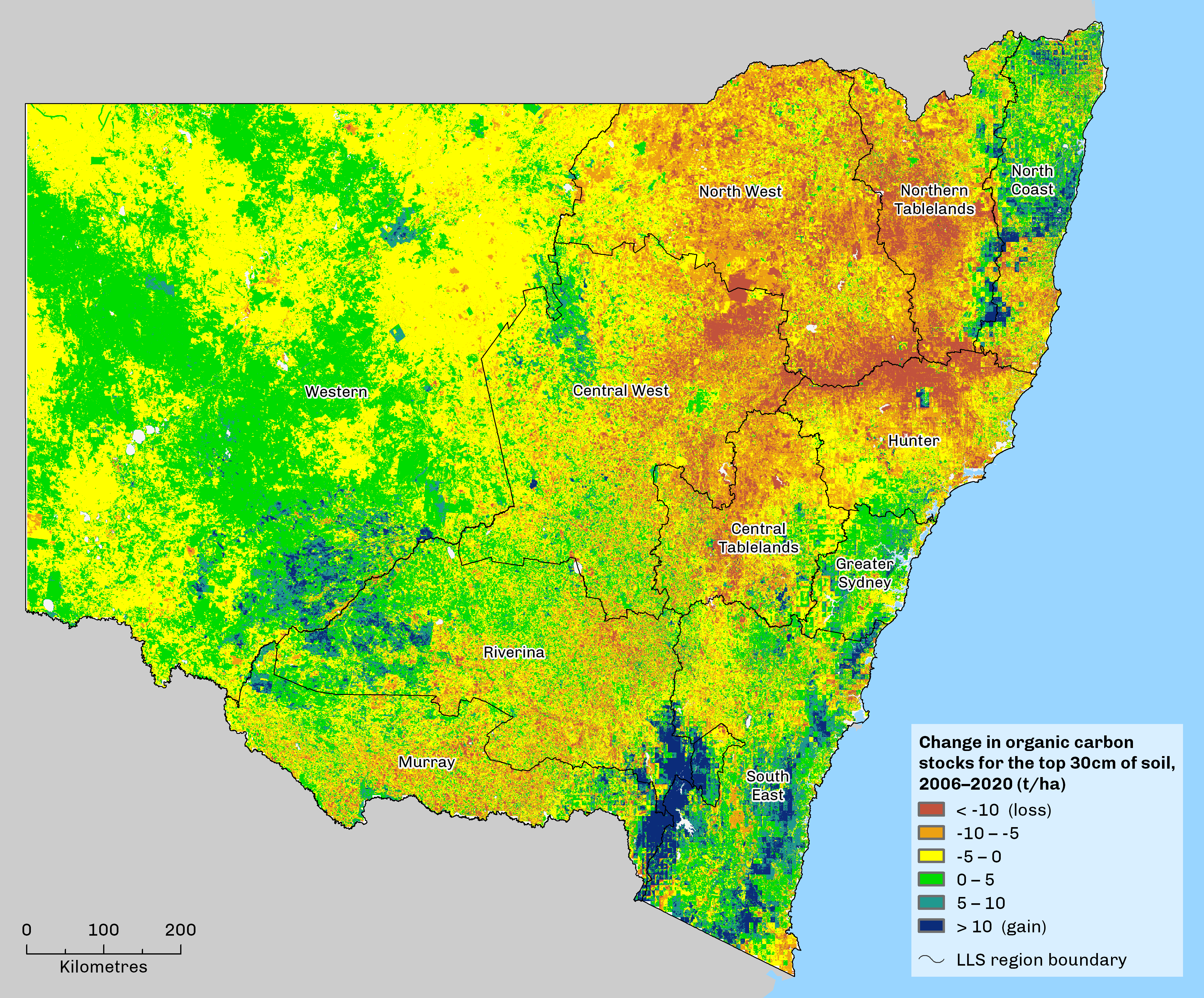
As shown in Map 10.5 and Table 10.2 (in the pH section above), the majority of LLS regions and NSW as a whole have experienced the change in SOC stocks over the 15-year period, with a statewide decline of 1.8 tonnes per hectare (t/ha). This compares with initial modelled stocks of 57.3 t/ha in 2006, a fall of 3.1%.
Only the Greater Sydney and North Coast regions reveal slight overall increases in SOC stocks. The largest declines in stocks were evident in the North West, Northern Tablelands and Hunter LLS regions, with mean declines of 6.6, 6.4 and 6.3 t/ha, respectively.
Part of this decline is attributable to the overall drier conditions (higher temperatures and lower rainfall) across NSW during this period. However, changes to more intensive land uses across many regions, such as from grazing to cropping activity with its associated lower vegetation cover, have also contributed to the decline.
These reductions in SOC stocks over much of the state are consistent with the declines since pre-European times modelled by Gray et al. (). Those results suggested that 530 million tonnes of SOC, (12.6% of the original stocks) have been lost from the top 30 centimetres of soils across NSW since European settlement. The extent of SOC decline varies according to the land-use regime, with the greatest reduction of almost 45 tonnes per hectare (a 50% loss) modelled under regular cropping of high fertility clay soil in cool and moist conditions.
Similarly, recent modelling spatially identify locations and environmental regimes across NSW with the highest potential for SOC sequestration under improved land management scenarios (; ). An analysis of SOC change under projected climate change to approximately 2070 revealed potentially substantial SOC losses, averaging 5.1 t/ha in the 30 cm layer across NSW, but exceeding 20 t/ha in highland areas (; ).
These studies allow us to better identify areas and strategies to focus on retaining carbon in our soils as a means of achieving net zero emission and mitigating climate change.
Hillslope erosion
Historically, hillslope erosion has contributed to extensive soil loss and an associated decline in ecosystem function. The current reporting period (2018–2020) has revealed a great variation in the status of hillslope erosion in NSW.
Hillslope erosion rates decreased significantly in 2018 to 0.6 t ha-1 yr-1 before falling even further to 0.4 t ha-1 yr-1 in 2019 due to the prolonged dry spell which delivered a state average of only 256 mm rainfall that year. A sharp increase in frequent and intense rainfall events in 2020 and severe bushfires which destroyed much vegetation cover in many parts of the state saw the erosion rate soar to 1.8 t ha-1 yr-1, the highest since 2000.
The extent of hillslope erosion changes with the climate and vegetation levels. Bushfires have a great impact on erosion as was evident when erosion rates in some areas severely affected by fires, such as the Sydney drinking water catchment, increased by about 30 times in February 2020 ().
The average annual rate of hillslope erosion across NSW for the 2018–2020 period was derived by modelling based on the Revised Universal Soil Loss Equation (; ) and is shown in Map 10.6. The change in annual erosion rates from the baseline period (2000–2017) to the current period is shown in Map 10.7.
Map 10.6: Annual mean hillslope erosion 2018–20
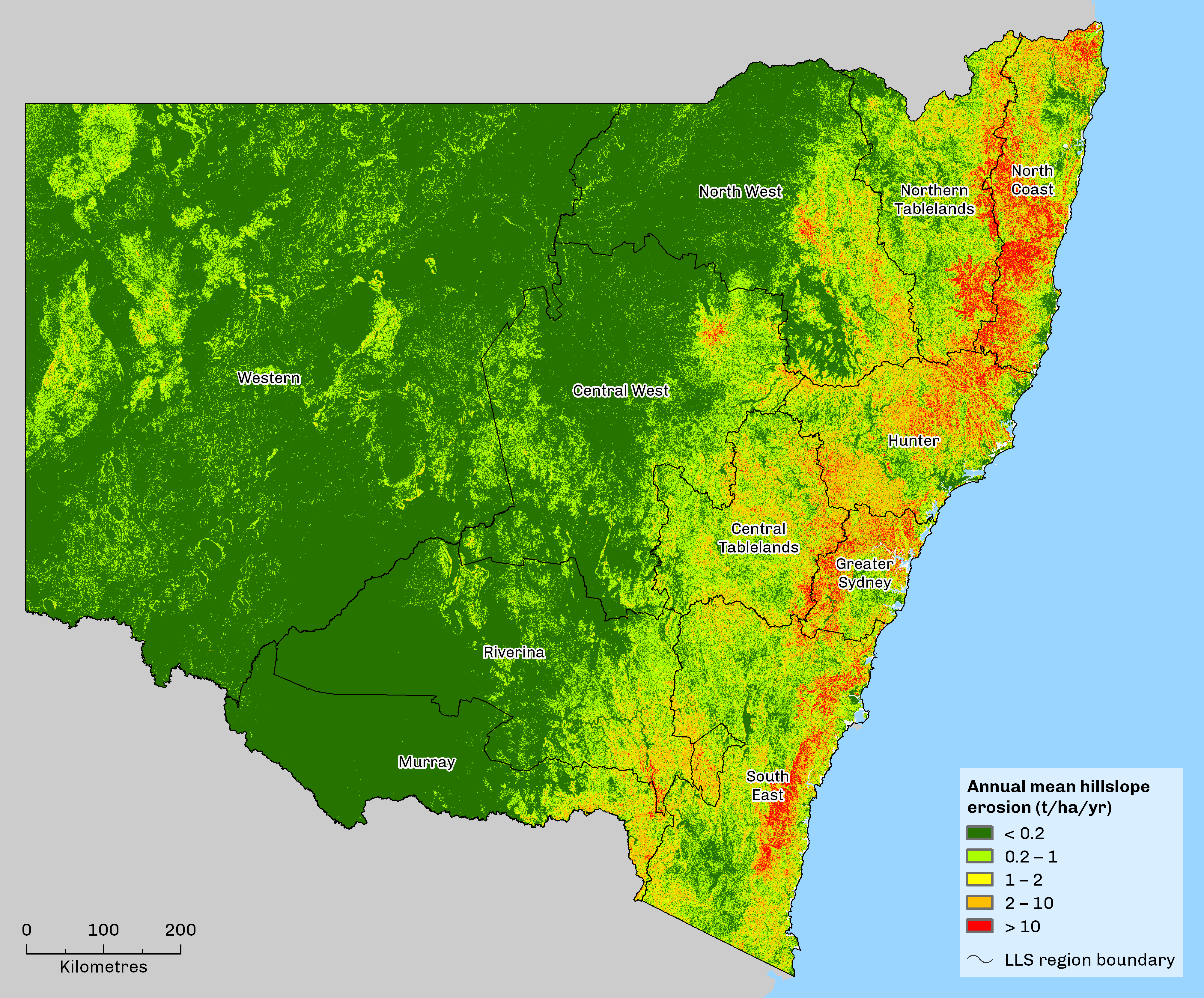
Map 10.7: Change in annual mean hillslope erosion rate, baseline to 2018–20
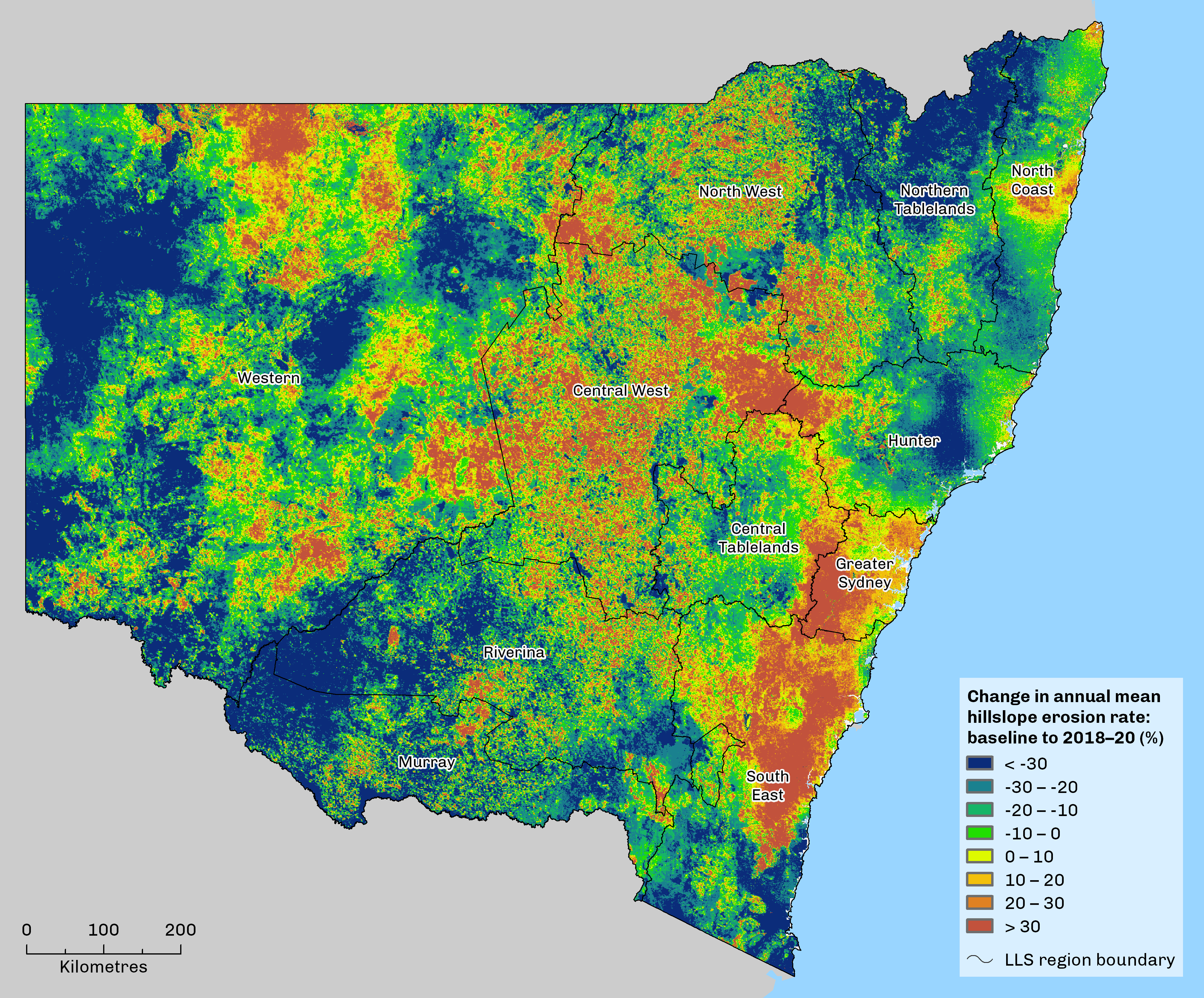
The areas of highest erosion for the 2018–2020 period (2018–2020) were unchanged from previously, being the North Coast, Hunter and Greater Sydney LLS regions. The Western region has the lowest levels due to its flat terrain. Erosion rates range from 0.13 tonnes per hectare per year in the Western region to 4.8 t/ha/yr in the North Coast region, differing by a factor of about 36 and slightly higher than the previous reporting period. The greater variation in erosion rates was largely due to the 2019–20 bushfires and storm events in 2020 across eastern NSW (North Coast, Greater Sydney).
The yearly averages for rates of hillslope erosion between 2018 and 2020 across NSW are presented in Figure 10.1 which shows:
- the average erosion rate for the three years was 0.94 t/ha/yr
- the average hillslope erosion rate for the baseline period (2000–17) was 1.0 t/ha/yr
- hillslope erosion over the past three years of data decreased by 6.5% compared to the baseline period
- the majority (77.2%) of NSW had an erosion rate less than 0.5 t/ha/yr (arguably the tolerable erosion rate), while an area of only about 5.3% experienced above this.
- The 2020 year had the highest erosion rate (1.80 t/ha/yr) over the past 20 years.
Table 10.2 in the Soil pH section above details the percentage change in hillslope erosion 2018–2020 compared with 2006–2018 by LLS region.
Figure 10.1: Hillslope erosion in NSW for the 2000–20 period
There is great variation in hillslope erosion rates between seasons, as well as years. Summer is the season with generally the lowest groundcover levels and highest rainfall erosivity, thus the highest hillslope erosion risk. Based on average monthly erosion rates between 2000 and 2020, the risk of hillslope erosion in February is about 10 times higher than in July. The variation in average annual hillslope erosion rates is 2.46 times.
Hillslope erosion also varies greatly according to land use with the following estimated rates for different land uses in tonnes per hectare per year:
- nature conservation (3.38)
- production forestry (2.92)
- mining (1.40)
- grazing modified pastures (0.82)
- grazing native vegetation (0.43)
- cropping (0.17)
- irrigated cropping (0.04).
Erosion rates can be explained by the associated groundcover and terrain factors. In nature conservation areas, such as national parks, the relatively high rate is attributable to the steep terrain they often occupy and the impact of bushfires. The relatively low erosion rates in cropping areas are due to the flat terrain and effective erosion control through conservation farming techniques.
Wind erosion
Wind erosion, like hillslope erosion, has historically contributed to extensive soil loss and the decline of soil condition throughout NSW, primarily in the drier western regions. However, during the period 2017–20, there was an extreme drought with record low rainfall in NSW, which according to the Bureau of Meteorology (2021), had ‘no clear historical precedent’. This resulted in large areas of the sheep/wheat belt in central NSW suffering from wind erosion.
The 2019-–20 drought resulted in total vegetation cover at record low levels, with only 69% of the state had the 50% or more of total vegetation cover necessary to protect it from wind erosion. This was 10% lower than the 2009–10 period, the last big drought year. The outcome of these extreme dry conditions was increased hours of wind-borne dust.
Dust in the air is an indicator of wind erosion degrading soils in regions further up-wind. Dust activity is measured by the number of hours per year that the average dust concentration exceeds 25 micrograms per cubic metre (µg/m3). Monitoring data is available from the Community DustWatch program which has 21 sites west of the Great Dividing Range with 13 years of records.
Dust activity tends to be related to season, with spring, summer and autumn having the higher levels. For this reason, yearly data is presented for the 12 months July to June.
For the 2017–20 period, dust hours recorded per year were 4.2 times the average levels of the previous 10 years. This indicates the status of wind erosion for the current reporting period considered poor and getting worse across NSW with negative impacts on soil loss and air quality.
Figure 10.2: Average dust hours recorded at NSW DustWatch stations 2008–20
Notes:
The green horizontal line is the average of the baseline (2007-08 to 2016-17) and the blue line is the average for the reporting period 2017-18 to 2019-20. DustWatch data 2020
Map 10.8 shows the average number of dust hours per year (size of circle) at NSW rural air quality monitoring (DustWatch) stations for the three years 2017–20, along with the change in dust hours (colour of circle) for those years compared to the previous 10 years (2007–17).
Map 10.8: Status and change in the average number of dust hours recorded at NSW DustWatch stations for the 2017–20 period compared to the 10-year mean for 2007–17
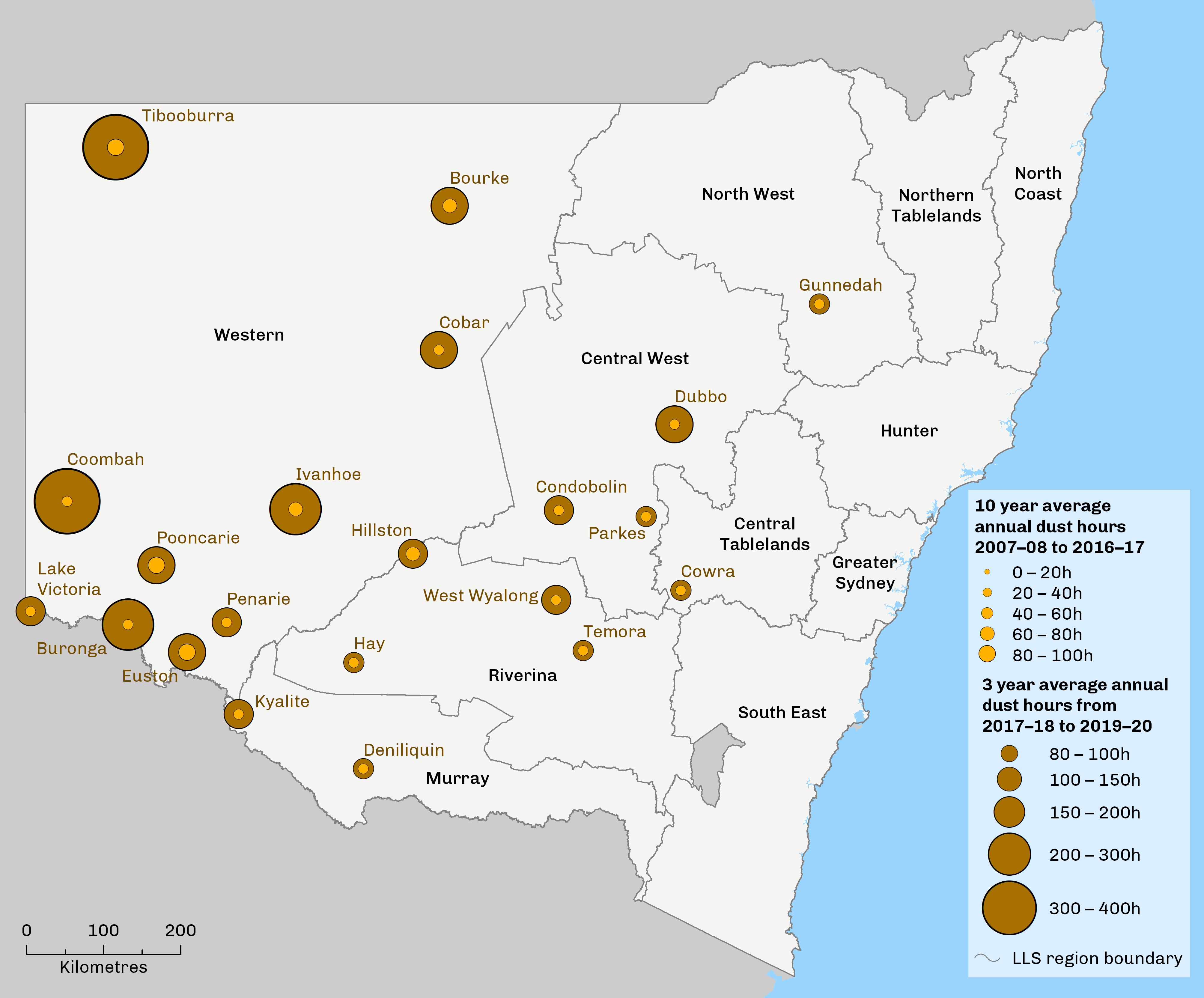
Notes:
Access the interactive version of this map.
Status (size of circle) and trend (colour of circle) for change in the average number of dust hours per year between 2014–15 to 2016–17.
Results across the monitoring sites reveal:
- between 2017–18 and 2019–20, Coombah was the dustiest place in the state with a yearly average of 363 hours of dust
- Tibooburra was the dustiest site for any year in the 13-year record with 636 hours in 2018–19
- unlike 2009–10 when most of the dust was measured in the west of the state, in 2019–20 towns like Dubbo and Temora in the Central West wheat belt also recorded significant dust levels above 278 hours.
These dust levels closely correspond with the total vegetation cover results. For example, 95% of the Central West Local Land Service (LLS) region was protected from wind erosion in 2009–10, compared to only 67% in 2019–20. The impact of dry weather on total vegetation cover and resultant dust levels is a feature of the 2017–20 period.
The level of groundcover is a good predictor of wind erosion, reflecting the effects of climate and land management. Dry years result in less soil moisture, making it harder for land managers to maintain sufficient cover as an effective control of wind erosion. Land management practices, such as maintaining high stock levels, cultivation and the burning of crop residues, all contribute to reduced groundcover. Additional pressures arise from unmanaged herbivores, such as goats and kangaroos, which may require control. Furthermore, dust levels recorded in NSW may also be affected by dust coming from the adjoining states of Queensland, South Australia and Victoria.
Figure 10.3 shows the average area of less than 50% groundcover has increased from a previous 10-year average of 14% to 25% over the past three years, attributable to extreme climate conditions. In the 2017–20 period, two years in a row had over 30% of the area with less than 50% groundcover, the level required to control wind erosion. Prior to this, only one year (2008–09), has exceeded 30% for this metric. Consecutive years with insufficient groundcover results in significantly more dust being produced than just a single year.
Figure 10.3: Average area with less than 50% total vegetation cover recorded near NSW DustWatch stations 2006–20
Notes:
Data is for groundcover in areas within 50 kilometres of NSW DustWatch stations.
Horizontal bars are averages for the 12 years 2005–06 to 2016–17 and latest three-year period 2017–18 to 2019–20 respectively.
Salinity
Salinity remains a land degradation issue of some concern across NSW, with detrimental impacts on agriculture and infrastructure. Soils in several regions around the state are subject to high salinity risk, which is influenced by prevailing climatic conditions. Salinity is currently considered to be moderate in NSW with a predominantly stable trend.
There has been no recent quantitative assessment of soil salinity in NSW. However, a generalised qualitative salinity hazard map for most of NSW can be compiled based on salinity hazard assessments for the water quality component of NSW Water Resource Plans (2017–18), together with previous Hydrogeological Landscape (HGL) hazard assessments (2008–20) and salinity hazard assessments for catchment action plans (2012).
Overall salinity hazard ratings are based on the likelihood that salinity will occur and its potential impact. Assessments consider both the on-site impacts of salinity on the land and the off-site impacts in streams of salt concentrations and loads. The severity of each of these will vary depending on local factors that influence how salt and water move through the landscape. The distribution of salinity hazard across NSW is shown in Map 10.9.
Map 10.9: Overall salinity hazard assessment for NSW, 2020
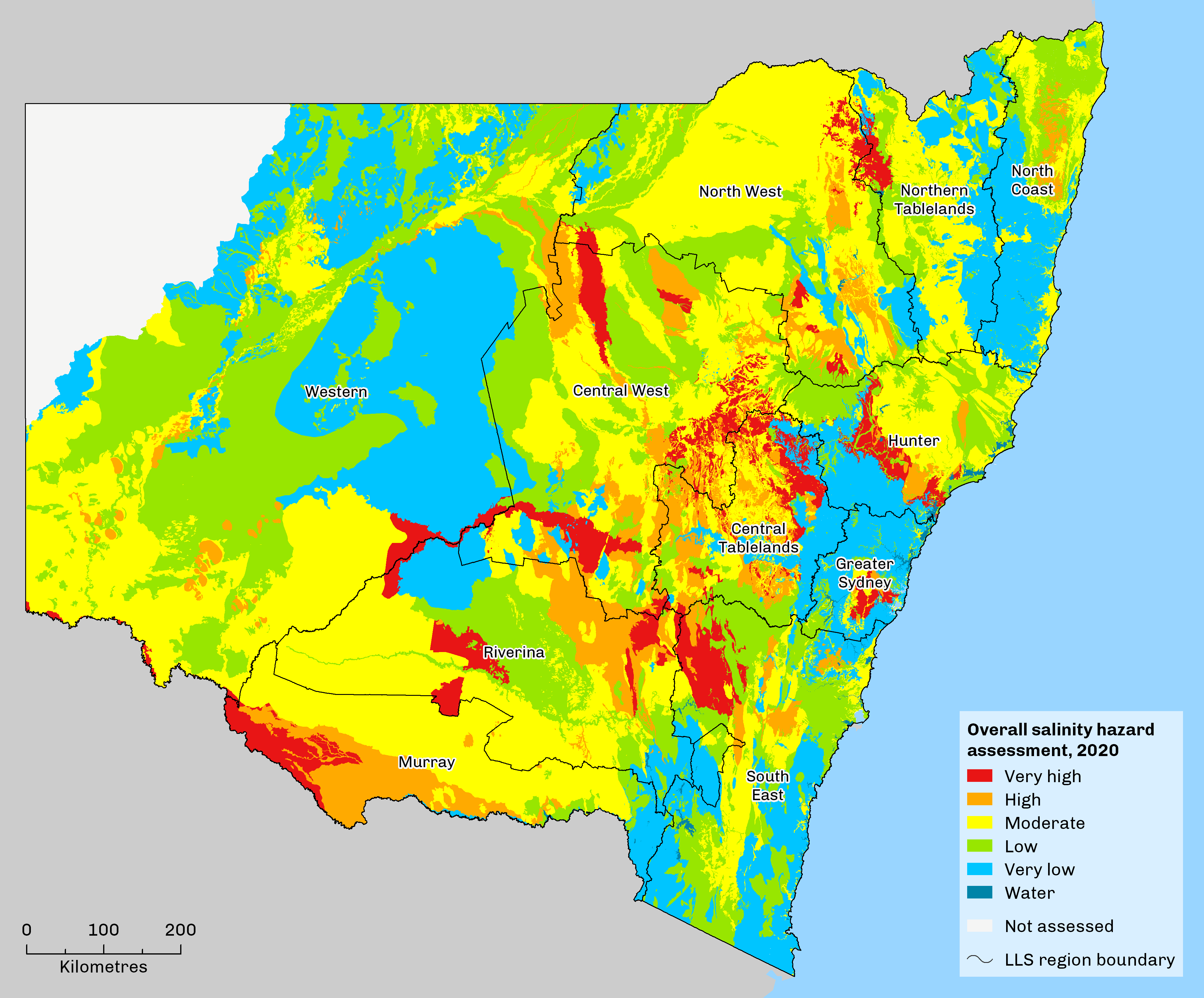
Approximately 12% of NSW contains landscapes where areas of high or very high salinity hazard may occur. Areas of concern include:
- the Hunter and Central West regions
- the Greater Sydney, Yass and Boorowa regions
- the mid and lower Murray and Murrumbidgee irrigation areas.
Significant impacts on land and local infrastructure may occur in high hazard areas, as well as streams in the catchment area.
NSW Water Resource Plans have assessed areas in the Murray–Darling Basin (MDB) for salinity hazard. The MDB Authority also maintains a register of salinity credits and debits to keep account of actions that affect salinity in the basin.
With climate change, the salinity risk is expected to increase in the northern part of the state. Salinity has been recognised as an issue in the north west, but there has been insufficient resourcing to fully assess the situation.
Future changes in rainfall and evaporation in all regions (; ) will affect the balance between runoff and overland flows and shallow and deep drainage. These changes will affect the mobilisation and concentration of salts. Impacts on soil salinity are likely to be complex and difficult to predict. Local factors will also play a part in whether salinity will increase or decrease in particular areas.
Acid sulfate soil
Acid sulfate soils (ASS) are soils containing pyrites (iron sulfide). Exposure of these soils to the air through excavation or water drainage projects, where previously they were saturated with water, causes the release of highly acidic solutions and serious environmental impacts, particularly in coastal estuarine areas. With improved understanding and land management practices, such as shallower drainage channels, the severity of this issue has decreased.
The extent of ASS over NSW coastal lands is presented in the NSW ASS Risk Maps. Assessment of NSW coastal ASS, carried out in 2009 and reported in OEH (), found the overall condition of ASS soils was moderate. However, 23% of the sites assessed were poor or getting worse.
Since then, ongoing remediation of problem areas has improved the condition of these soils. Of the 28 ASS hotspots identified, remediation works have now been carried out in 21. In particular, Everlasting Swamp has been restored and remediation works to restore tidal flows continue at Yarrahapinni Wetlands National Park. At Big Swamp on the Manning River, Midcoast Council continues to purchase and restore degraded wetlands. See the Responses section for more details.
It is now known that areas of high ASS soils also occur in NSW inland river valleys (). For example, Tulau & Morand () found half of the 60 sites examined along the banks of the Edward-Wakool River system were sulfidic and prone to the release of acidic solutions into the riverine environment. The return of moist la Niña conditions has temporarily ameliorated this issue.
Pressures
Unsustainable land management and land use
When European settlers arrived in Australia, they continued to use traditional farming practices that had been developed for different soil and climate conditions in another part of the world. Much of the soil degradation in NSW is historic in nature and occurred before an understanding of how to manage soils sustainably in Australian conditions.
The development of modern land management systems, such as conservation farming, pasture rotation and minimum-tillage, together with better maintenance of groundcover, has largely halted, and in some cases reversed, the decline in soil condition. However, there is still some way to go before best practice land management is implemented consistently across the state.
While land management practices have generally improved, the pressure on soil condition continues due to the increasing intensity of land use across NSW. There is, therefore, a greater need to ensure that soils and land are managed sustainably and within their inherent physical capacity to handle a specific level of disturbance or use. This will help ensure the long-term productive use of NSW soils, the maintenance of ecosystem services and protection of the environment.
As part of the NSW Monitoring, Evaluation and Reporting (MER) Strategy program as reported in OEH () and summarised in SoE 2015 (), an assessment was made in 2008–09 of the extent to which soils were being managed within their capability.
The pressure on soil condition from various land uses across NSW and the levels of soil disturbance associated with them is represented by the land disturbance index (LDI). This assigns land use to one of six classes from Class 1 for undisturbed land, such as native vegetation reserves, to Class 6 for intense cropping land (; based on ). Map 10.10 presents the change in LDI from approximately 2005 to 2017, based on land-use information collected by the NSW Government.
Map 10.10: Change in the land disturbance index from approximately 2005–17
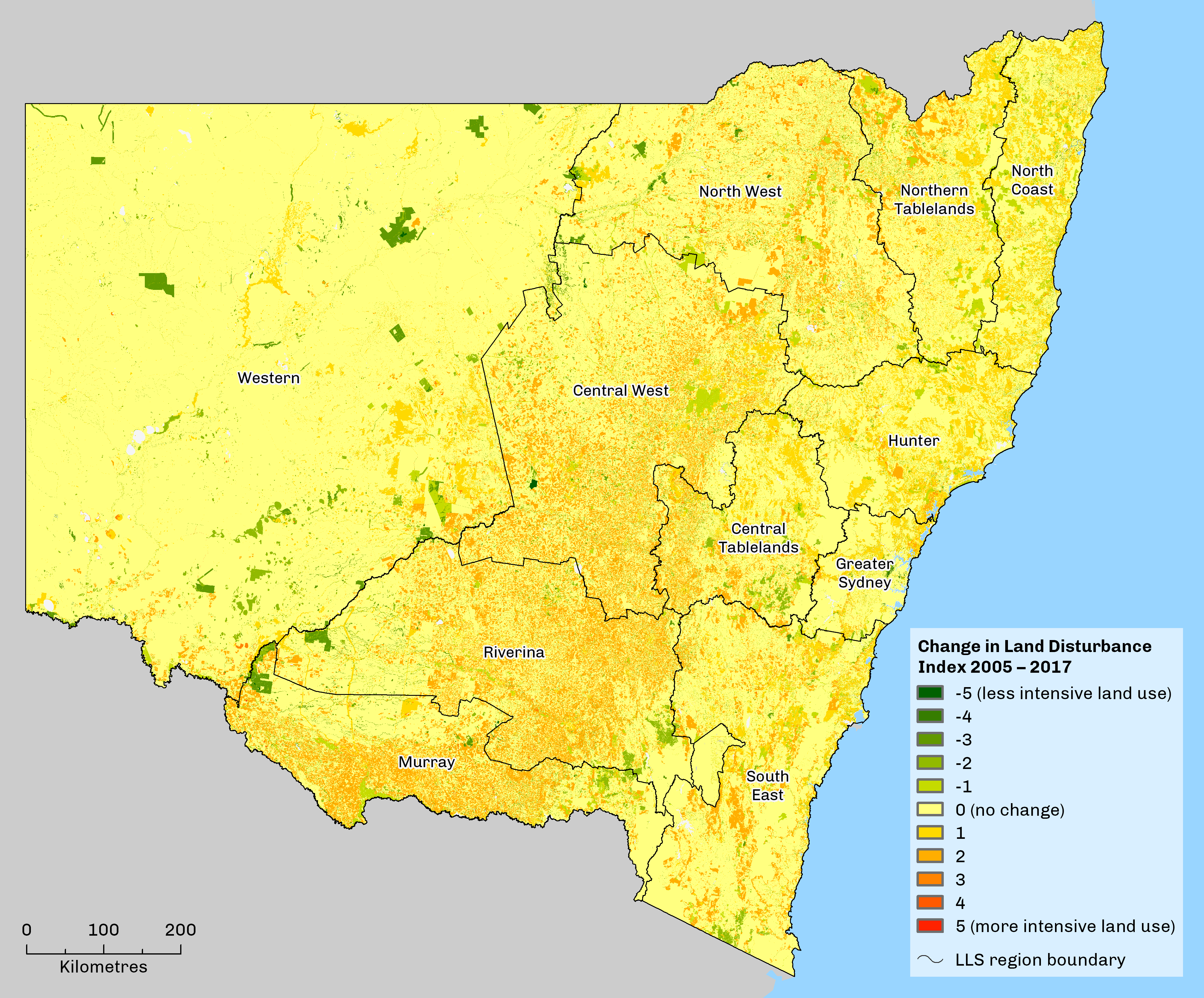
An overall trend towards more intensive land use over recent years is revealed by the map, with a statewide increase in the LDI of 0.20 units (see Table 10.3).
Table 10.3: Change in the land disturbance index from approximately 2005–17 by LLS region
| Local Land Service region | Change in land disturbance index (units) |
|---|---|
| Central Tablelands | +0.29 |
| Central West | +0.37 |
| Greater Sydney | +0.11 |
| Hunter | +0.25 |
| Murray | +0.40 |
| North Coast | +0.17 |
| North West | +0.19 |
| Northern Tablelands | +0.27 |
| Riverina | +0.44 |
| South East | +0.27 |
| Western | +0.01 |
| NSW | +0.18 |
The LLS regions with the largest average increases are the Riverina, Murray and Central West (0.44, 0.40 and 0.37 units, respectively). Many locations throughout the state, particularly in these regions have increased by two LDI units, which represents a change in land use from predominantly pasture to predominantly cropping.
However, some areas, particularly in the Western region, have changed to less intensive land uses, shown by the deep green in Map 10.10. This may, for example, reflect a change in land use from pastoral lands to a protected conservation area. While a change in land management has occurred, a change in site conditions may not be immediately evident.
Although land-use intensity appears to be increasing slightly across NSW, as revealed by Map 10.10 and Table 10.3, land management practices may be improving simultaneously in many regions to compensate.
For example, the Western region has a long history of wind erosion. The National Landcare Program and Catchment Action NSW have invested in changing land management practices on farms in this region, resulting in an increase of sites using best management practices from 15% in 2003 to 74% in 2020 (see in Figure 10.4). This is an excellent result as it shows the best land management practices persisted during the 2017–20 drought.
Figure 10.4: Trend in the use of best management practices in the south-west of the Western LLS region, 2003–20
Notes:
Trend in best management practices in the south-west of the Western LLS region
Climate change
While soil may be managed sustainably with little risk of degradation during normal weather patterns, the unpredictability and variability of severe weather events can rapidly reduce the soil’s capacity to absorb disturbance, leading to loss of soil condition and degradation.
Climate change has brought more extreme weather events and generally drier conditions across much of NSW (; ), increasing the challenge to manage for weather variability and extremes, such as high erosivity rainfall events, increased fire and drought. A decline in soil carbon across NSW and south-eastern Australia is projected (, ). A changing climate will require a rethink of the way that soils and land are currently managed by geographic locations. Without adjustments, it is possible that land may be used beyond its capability.
Programs that encourage soil carbon sequestration, such as the NSW Government’s Net Zero Plan () and the Australian Emission Reduction Fund, promote land management practices that have that have associated benefits for soil condition ().
Climate change will also increase the risk of some soil degradation hazards, particularly wind erosion and loss of soil carbon (; ). For more information, see the topic.
Changed population and settlement patterns
Rising population in urban areas and increased demand for food at various levels – local, regional, national and international – is leading to an intensification in the use of productive land and greater risk of soil degradation. At the urban fringe, highly productive land is coming under growing development pressure, while population loss from rural areas reduces the capacity to manage land effectively (see ).
Economic factors
Economic factors, such as declining farm profitability and poor international trading conditions, can lead to an intensification of land uses and production activities in order to maintain viability, which may not be sustainable over the longer term. However, increasingly higher expectations of environment protection by markets, consumers and the finance sector may also drive improvements in land management practices.
Increasing fuel prices and competition for essential resources like water and fertilisers are other significant factors that pose challenges for managing the land sustainably ().
Responses
Legislation and policy
The Soil Conservation Act 1938 provides for the conservation of soil and water resources and the mitigation of erosion across NSW and also established the Soil Conservation Service, now a NSW Government-owned soil conservation and environmental consulting business.
The Local Land Services Act 2013 regulates the clearing of native vegetation on rural lands while the Biodiversity Conservation Act 2016 promotes conservation. These settings aim to achieve a balance between land use and biodiversity conservation in NSW.
Clearing of native vegetation in urban areas and land zoned for environment protection are regulated by State Environmental Planning Policy (Vegetation in Non-Rural Areas) , as well as some provisions in the Biodiversity Conservation Act that provide for the biodiversity offsets scheme. For more information, see the topic.
The current approach to soil management in NSW is to consider soils as part of broader natural resource management rather than a standalone issue (). Specific policies for sustainable soil management in NSW include:
- the State Environmental Planning Policy (Rural Lands) 2008
- the Policy for Sustainable Agriculture in NSW ().
NSW is a signatory to the National Soil Strategy () which provides a national framework for coordinated action on soil by governments, industry and stakeholders. The Commonwealth has committed to significant new investments as part of its Interim Action Plan to set out how Australia will value, manage and improve its soil over the next 20 years. The strategy aims to:
- prioritise soil health
- empower soil innovation and stewards
- strengthen soil knowledge and capability.
The Emissions Reduction Fund provides funding through a reverse auction mechanism to enable land managers to be financially rewarded for sequestering carbon.
Programs
Local Land Services
Eleven regional Local Land Services (LLS), are working with local farmers, landholders and communities, including Landcare groups, to develop strategies and programs to improve natural resource management and sustainable land use across NSW.
Landcare and other on-ground initiatives
Landcare is a community network that contributes to the integrated management of natural resources at the grass-roots level across NSW, including improved soil management and land remediation.
About 3,000 Landcare groups are currently working in NSW to:
- reduce soil and streambank erosion
- control weeds
- revegetate river banks, farmland and other public lands.
Landcare groups also promote the sustainable use of soils through education and community awareness programs.
NSW Government funding of the Landcare program to 2023 is supporting the network of NSW Regional and Local Landcare Coordinators who work with LLS and other organisations across NSW to build the capacity of the Landcare movement to achieve its goals of:
- improving natural resources
- encouraging sustainable agriculture
- empowering communities to improve their local environments.
Phase 2 of the National Landcare Program is currently underway, a major component being Regional Land Partnerships which is investing $450 million from July 2018 to June 2023 towards environmental and sustainable agriculture outcomes.
Catchment Action NSW is a NSW Government-funded program to deliver natural resource management priorities, generally in conjunction with National Landcare. One high-level outcome is to protect and rehabilitate soils to support ecosystem services.
Farmers and landholders across NSW are also independently adopting improved land management practices, due to a greater awareness and commitment to sustaining their land management operations and protecting environmental values.
Advisory bodies and instruments
The Natural Resources Commission provides independent advice to the NSW Government on how to most effectively manage natural resources that maintains production and conservation. The commission works with NSW regional communities and other stakeholders to improve or maintain the health and productivity of landscapes across NSW.
The Australian Soil Network oversees soil research and development strategies and their implementation throughout Australia. With representatives from rural research and development corporations, government agencies, CSIRO and the university sector, the network is currently co-chaired by the NSW Department of Primary Industries and the Grains Research and Development Corporation.
The National Committee on Soil and Terrain coordinates and provides advice on soil and land assessment standards and policy. National protocols for monitoring soil acidification and soil carbon have been published ().
The National Committee for Acid Sulfate Soils (NatCASS) works with the Commonwealth Department of Agriculture, Water and the Environment to develop guidelines on acid sulfate soil (ASS) management issues that are not being adequately addressed in some jurisdictions, including:
- groundwater management in areas of ASS
- dredging of sulfidic sediments
- managing monosulfidic black ooze accumulations.
NatCASS has also completed a Code of Practice for the re-use of ASS materials that are excavated and removed from development sites. Guidelines for the identification and management of inland ASS were developed through the National Water Quality Management Strategy ().
The management of salinity throughout NSW is guided by NSW Water Resource Plans in combination with the Hydrogeological Landscape program.
Research, development and data collection
The National Soil Research, Development and Extension Strategy () provides over-arching guidance on relevant soil issues and solutions and seeks to drive strategic investment and collaboration to improve soil condition. The NSW Government supports and leads this strategy on behalf of stakeholders. It is referenced in the recently released National Soil Strategy ().
The NSW Department of Planning, Industry and Environment (DPIE) collects data on soil and land management processes, conducts surveys, undertakes research and maintains NSW soil data through eSPADE.
The NSW Department of Primary Industries has a large research, development and adoption program that develops technologies and management systems to:
- maintain and enhance the physical, chemical and biological productivity of soils
- protect soil resources
- build resilience and reduce environmental impacts.
It works in partnership with Local Land Services and private stakeholders to ensure research and development findings are adopted by stakeholders.
Monitoring programs
The cross-agency collaborative rural air quality monitoring (Community DustWatch) program has been monitoring the extent and magnitude of dust events across NSW for the past 13 years. NSW Government agencies also lead the national assessment of wind erosion ) and the use of remote-sensing to assess the extent of groundcover.
Under Phase 2 of the National Landcare Program, groundcover will be a key reporting indicator, with the reporting methods developed in NSW proposed for use nationally.
A program of monitoring soil condition in the forests of eastern NSW is being initiated under the Forest Monitoring and Improvement Plan by the NSW Natural Resources Commission.
References
DECCW 2009, New South Wales State of the Environment 2009, NSW Department of Environment, Climate Change and Water, Sydney


